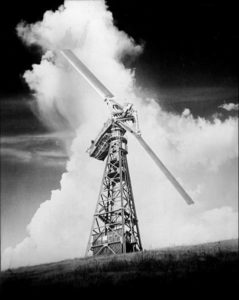The Unlikely Birth of Modern Renewable Energy On A Mountain Top in Vermont – 75 Years Ago Today

Seventy-five years ago today, at 6:56 PM, the modern renewable-energy era began. On a mountain in Vermont called Grandpa’s Knob, the world’s first megawatt-scale wind turbine was connected to the electric grid, generating power for thousands of people living in the Champlain Valley below. President Franklin Roosevelt’s science advisor, Vannevar Bush, would later write that “the great wind-turbine on a Vermont mountain …proved that at some future time homes may be illuminated and factories may be powered by this new means.” Fast forward 75 years and wind is indeed a fast-growing electricity source; more new megawatts of wind power were added globally in 2015 than any other power source, with about $100 billion in related investment. Yet wind still provides less than 5% of global electricity generation.
The story of the Grandpa’s Knob wind turbine is a cautionary tale about just how long and hard it is to get an energy technology to commercial scale and the obstacles that remain for wind to become a significant tool in confronting climate change.
In the late 1930’s, Palmer Putnam, an MIT-trained engineer and Cape Cod sailor, was struck by the power and consistency of ocean breezes and bothered by the high electricity rates for his all-electric home. The small wind turbines at that time only pumped water or charged batteries. Putnam decided it was time to go big—hundreds of times the power output of these tiny machines—and connect new megawatt-scale turbines to a fast-growing U.S. grid, increasingly powered by ever-larger hydroelectric dams. Palmer envisioned a future with utilities storing water behind these dams when the wind was blowing and running the hydropower generators hard when it wasn’t.
In 1937, Putnam and General Electric approached the New England Public Service Corporation, a regional electric company. The S. Morgan Smith Company, a leading hydropower-turbine manufacturer, agreed to develop the breakthrough machine. The project was launched in October 1939. Two years later, the “Smith-Putnam” turbine was ready for prime time – its 100-foot tower hauled to the top of Grandpa’s Knob and its two 60-foot stainless-steel blades attached to the tower by a large crane.

In gusty 25-mile hour winds on October 19, 1941, high above the whitecaps on Lake Champlain, the 1.25-megawatt turbine was connected to the Vermont grid, the first time ever that wind power was fed into the high-voltage lines of a utility system. The turbine operated on and off for the next five years, facing winds of up to 115 miles per hour. Then, in March 1945, one of its eight-ton blades broke from the turbine’s hub and was tossed 750 feet landing on its tip. With World War II still raging, and the cost of the project exceeding initial estimates, Putnam and colleagues halted the project. The team had proven that megawatt-scale wind turbines could work technically, but without funding to build the next set of commercial units, they could not prove they could succeed economically. Putnam was stuck in what has come to be known as the “Valley of Death” – where an energy technology works from an engineering standpoint but its proponents lack the capital to establish it can succeed commercially.
Meanwhile, other energy sources beat Putnam to the punch. Five years after his success on Grandpa’s Knob, a government-funded nuclear reactor in Idaho would generate electricity for the first time. Cheap coal-fired generation was increasingly dominating U.S. electricity supplies and later natural gas would give both energy sources a run for their money. But the patient visionaries and hard-nosed wind engineers who followed Putnam didn’t give up. With the 1970’s energy crisis, the U.S. government backed wind-energy R&D, California entrepreneurs began to develop wind farms in blustery passes, and the Danes led the way in Europe. Support for wind power waned with the end of the energy crisis, but in the 1990’s larger and cheaper wind turbines hit the market, and concerns rose about carbon emissions from fossil-fueled power plants. In the 2000’s, with a push from government incentives and mandates, the global wind industry saw hockey-stick growth, with Texas, the heart of the oil patch, leading the nation.
Despite the recent success of wind power, the industry, working with governments around the world, must surmount three major obstacles in order for wind power to finally achieve its global carbon-cutting potential: overcome the high cost and technical hurdles of storing intermittent renewable power; accelerate the process for siting and building wind farms and long-distance transmission lines; and find vastly larger amounts of low-cost capital, mostly from private-sector investors and measured in the trillions of dollars. And all of this must happen fast, driven by a climate crisis that grows worse each day.
Happily, there is a bright spot. The wind industry is going off shore, capturing the virtually unlimited resource that originally inspired Putnam, with ever-larger turbines at rapidly falling cost. And the industry is progressing from offshore turbines that sit on the sea bottom in shallow waters to a new generation of machines attached to floating platforms tens of miles from shore, beyond the views of coastal residents and habitats of most marine birds and mammals. Seventy-five years after his successful experiment on Grandpa’s Knob, I would bet Palmer Putnam, wind power pioneer – and sailor – would be pleased.
Dan W. Reicher is Executive Director of Stanford University’s Steyer-Taylor Center for Energy Policy & Finance and previously served as Assistant Secretry of Energy in the Clinton Administration and Director of Climate Change and Energy Initiatives at Google.
